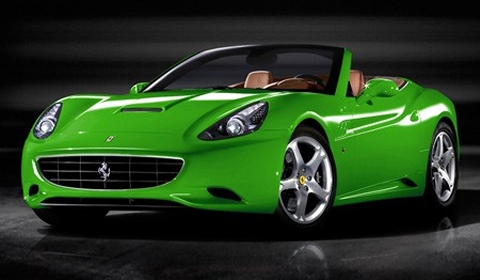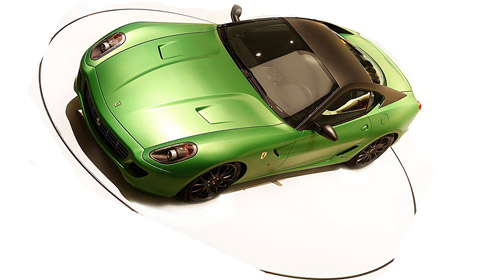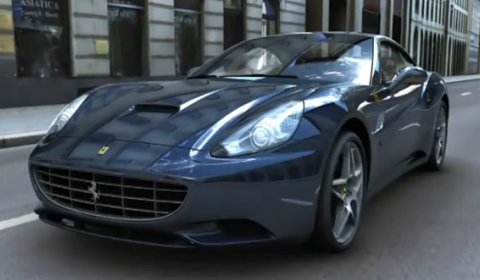
Ferrari is currently working on a hybrid supercar and there is solid proof that this green project is well under way.
Following the global pressure to reduce fuel consumption and CO2 emissions of cars, the manufacturers are working on technologies to make cars more environmental friendly. For example, Porsche is to use more hybrid drivetrains and lightweight materials to improve the efficiency of its vehicles. Lamborghini is aiming at weight reduction via the extensive use of lightweight materials.
Ferrari is working on a green supercar as well. The firm’s goal is to develop hybrid technology to get its fleet average CO2 emissions down to around 240g/km by 2018, a significant reduction from last year’s figure of 310g/km.

Ferrari 599 GTB Hybrid
At the 2010 Genève Auto Salon the Italians presented the Ferrari 599 GTB Hybrid. This experimental vehicle is an example of how the Italian manufacturer is approaching the development of hybrid technology into its future products. The Maranello based company has also filed a patent for a four-wheel drive hybrid vehicle.
We have already seen the Ferrari California equipped with the HELE-system designed to reduce C02 emissions without taking away from the joy of driving a prancing horse. This system results in a 23 percent reduction of C02 emissions.
The successor of the California is currently being tested. One mule was spotted in vicinity of Stuttgart, see the pictures at Autocar.co.uk. The car spied testing looks at first glance to be a mule for the upcoming 599 which will be unveiled in 2013. But do not let the appearance of the testcar fool you. For example, the Enzo prototype was disguised as a 348.
A closer look reveals this is actually a California. The California’s headlamps, wheels, chromed wheel nuts, folding metal roof shutlines, brake caliper position and distinctive instrument binnacle can all be seen.

Ferrari California equipped with the HELE system is designed to reduce C02 emissions.
A remarkable fact was that this car was equipped with a German registration plate. These plates show the place where the car carrying them is registered and this Ferrari mule was registered in Stuttgart, home of the world’s largest supplier of automobile components Bosch, which is thought to be helping Ferrari with the engineering and software set-up.
As noticed by Autocar, the revised arrangement of the test mule’s exhaust pipes is an important new detail. While the standard California stacks its twin rear pipes on top of each other, the test mule has two pairs of side by side pipes. This may be linked to new routings for the exhausts, dictated by the hybrid powertrain and its space-consuming battery.
This system would a further development of the one used in the 599 GTB Hybrid. The flat lithium-ion batteries are positioned below the floorpan. The result is a center of gravity that is even lower than in the standard car. The electric motor produces more than 100hp. Under braking the electric drive unit acts as a generator, using the kinetic energy to recharge the batteries.
More details about the Ferrari mule and the green future of the prancing horse are scarce, so stay tuned for more news!
[Via Autocar.co.uk and Autoblog.nl]
















first, no more manual gearbox, then hybrid engines… it’s the end of real sport cars
i mean really, who cares about reducing CO2 on a Ferrari? What is the point?
The point of reducing the emissions, even by Ferrari and Lamborghini, is the result of environmental awareness and regulations dictated by EU bureaucrats in Brussels. For example, the the European Commission proposed tough legislation to force down emissions of carbon dioxide from cars, with steep fines on manufacturers that fail to comply.
The EU argues that heavy fines are an effective deterrent to force manufacturers to invest in clean technology and produce lighter cars.
Initial plans by the European Union executive suggested fines for manufacturers whose fleets exceed an average of 120 grams per km. That is also the main reason why Aston Martin offers the small Cygnet, to keep the average fleet emission low.
@Chris: You are right. That’s why I hope Ferrari, Pagani, Lamborghini,Aston and every singe sportscar maker will leave the EU and go for example to Norway but then the import fees for these cars would explode.
What I’m I talking about? The EU will hopefully dissapear before something else happens.
@ Luke: Companies like Ferrari, Lamborghini or Pagani won’t leave the EU. That is something Italy won’t allow, the same applies for Germany. The first proposals made by the EU-bureaucrats resulted in a massive outrage of Germany. But also other EU-members weren’t happy with this proposal, for example Slovakia where the big SUV’s like the Audi Q7 and VW Touareg are manufactured.
Cutting down the fleet emissions to an average of 120 grams per km is a lot easier for, let’s say Fiat than for Ferrari. But it is also easier for the French car makers than for German car makers like Audi, BMW, Mercedes and Porsche.
Therefore this whole emission proposal will be watered down and compromised, due to strong pressure the industrial lobby. Italy wanted to protect small car manufacturers. Germany wants to protect its car industry.
As Europe’s requirements for its vehicle fleets head toward a goal of 98 grams of CO2 per kilometer by 2020, the only way the automakers can get there and make money is with plug-in vehicles. But I believe there is also an exception of the rules for small-volume manufacturers. This means that Pagani shouldn’t worry about the average fleet emission.
Sportscars are a part of the European cultural and industrial heritage and that is something will should be acknowledged. But even the small manufacturers should acknowledge that the automotive future will be green, with or without Brussels. Everybody wants to enjoy a clean environment, but most people would also like to enjoy the(ir) sport car. And I have no doubt the future will come with both possibilities.
IMO before sports cars they should restrict the aeroplanes. They pollute much more.
About that 120 grams per km it is about the whole fleet of the manufacturer not the make. Since Ferrari is owned by Fiat it means 120 grams averaged for all Fiats, Alfas, Lancias etc. Lambo is owned by Audi, which is owned by VW, which means 120 grams for all VW group fleet. Now because Aston Martin is not owned by other car manufacturer and they don’t own any other make they need to achieve this numbers only by Aston models. That’s why they made Cygnet. And I expect more like it in future. Maybe even electric Aston.
Chris, you are right. Pagani and Koenigsegg are not afected by this, ’cause they are low volume manufacturers. I’m not sure about the exact number of cars they are allowed to built though.
It is government regulations, nothing any company can do, even Ferrari can’t avoid it. It is ok, make the lame California a hybrid, as long as my future 458 is loud and runs dirty, I am good. Make the FF a hybrid too while they are at it, I will never drive one.
It is not only a EU thing, the US have the CAFE standard too. If Ferrari wants to sell cars here, they have to meet the CAFE standard also.